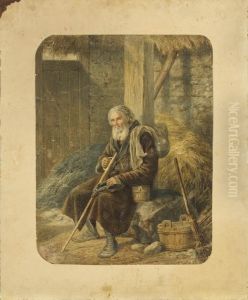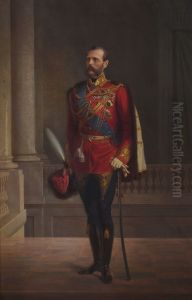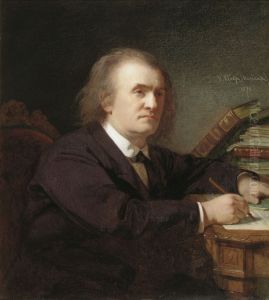Johann Koler Paintings
Johann Koler was an Estonian painter, often considered the founder of professional painting in Estonia and one of the most important figures in the country's art history. He was born on July 8, 1826, in the village of Ivaski in the Russian Empire (now in Estonia). Koler grew up in a peasant family, but despite his humble origins, he showed a strong interest and talent in art from a young age.
After initial education in local schools, Koler moved to St. Petersburg, Russia, where he worked as a house painter. His skill and dedication allowed him to save enough money to enroll in the Imperial Academy of Arts in 1848. He studied there for several years, honing his skills and focusing on portrait painting. Koler's work was recognized with several awards during his time at the academy, which helped establish his reputation as a promising artist.
Following his studies, Koler traveled extensively throughout Europe, further expanding his artistic experience. He visited Germany, France, Italy, and other countries, studying the great masters of European art and drawing inspiration from their work. Upon returning to Estonia, he became a pioneering figure in the country's art scene, bringing European techniques and sensibilities to Estonian painting.
Koler is best known for his portraits, which often depicted members of the growing Estonian national movement. His style combined realistic representation with a certain romantic idealism, characteristic of the mid-19th century. He was also the first to paint a series of works depicting Estonian landscapes, contributing to the development of national identity through art.
Throughout his career, Koler remained engaged with the Estonian art community, helping to lay the groundwork for the future development of the nation's arts and culture. He was not only a painter but also a teacher, sharing his knowledge and skills with the next generation of Estonian artists.
Johann Koler passed away on March 22, 1899, in Tallinn, Estonia. His legacy is preserved in his artworks, which are held in high esteem in Estonia and beyond. Today, Koler is celebrated as a national icon, and his contributions to Estonian art continue to be honored and studied. His works can be seen in museums across Estonia, including the Art Museum of Estonia (Eesti Kunstimuuseum), ensuring that his influence on Estonian art endures well beyond his lifetime.














